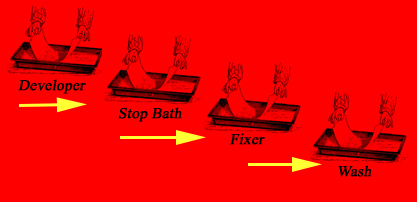Sequence viewing > Index > Photograms
- The ultimate Photogram resource > Resource > ©
Lloyd Godman
Photogram projects by Lloyd Godman - photogram artists
STOP
BATH
Next the print is placed into a stop bath for 45 seconds to 1
minute. As the developer is an alkaline and the stop bath is an acid,
this ensures development is halted immediately and also that no developer
is carried over into the fixer bath, so it keeps you chemical fresher.
It also eliminates the potential of dichroic fog where the developer
is carried into the fixer and the two chemicals react to fog the paper.
Remember
to use good working methods by allowing the chemical to drain off the
print into the tray before placing it in the next chemical.
A
wash bath of water can be used instead of the stop bath, but is slower
to use and less effective.
Stop
bath is usually made from acetic acid diluted to 1-40.
Be
careful with concentrated acetic acid ( Glacial Acetic Acid), as it
freezes at 12 degrees, so store it diluted to about 50%.
FIXING THE IMAGE
Once
the image is developed, it must be "fixed' to remove all the remaining
silver on the paper that was not developed up. Even though we can not
see them, these silver particles still remain on the paper and have
to be eliminated or they would keep developing once we turned on the
light and ruin the image over a long period of time. So it is most important
that the image is properly fixed. Usually with fresh chemicals and RC
paper (Resin coated) this takes 1-2 minutes depending on the
temperature of the chemical as long as the paper is agitated to allow
fresh chemical to reach all parts of the paper. With fibre based paper
this will take longer so check the manufactures instructions.
Fixer
can be tested for exhaustion by adding a few drops of a 5% solution
of potassium iodide. If the solution stays clear then is ok, if it turns
milky white then it should be discarded.

Want to learn more? - do a workshop or one on one with Lloyd Godman
|